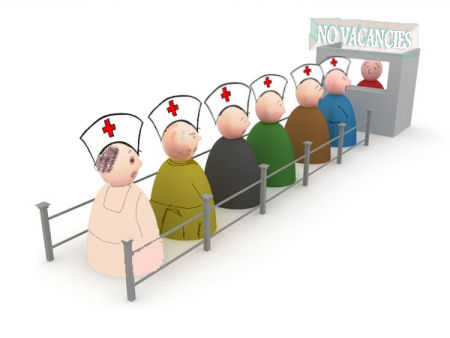
Candobetter.net Editor: All headings have been supplied by Candobetter.net and were not present on the original source, which is a speech in Hansard. For the original source go to Hansard, Wednesday, 4 June 2014, House of Representatives, p.15
Mr KELVIN THOMSON (Wills) (10:24): In my 2014 budget reply speech I said I was going to devote more time to health policy issues and become more expert in these matters. In delivering on that, yesterday I had the opportunity to speak at some length about preventive health and today I want to make some observations about our health workforce. The Health Workforce Australia Abolition Bill seeks to repeal the Health Workforce Australia Bill 2009 and absorb Health Workforce Australia's functions and programs into the Department of Health.

Australia’s complex health workforce arrangements
In 2006 the Productivity Commission report Australia's Health Workforce concluded that a more sustainable and responsive health workforce was needed. The report also highlighted the complexity of Australia's health workforce arrangements and the involvement of numerous bodies at all levels in health workforce education and training. In 2008 COAG agreed to the creation of a national health workforce agency that works across jurisdictions to establish more effective, streamlined and integrated clinical training arrangements and to support workforce reform initiatives. The Health Workforce Australia Bill back in 2009 established a national health workforce agency, Health Workforce Australia. Since its establishment Health Workforce Australia produced Australia's first ever national long-term projections for doctors, nurses and midwives with the publication in 2012 of Health Workforce 2025—Doctors, Nurses and Midwives. This report highlighted that under current policy settings Australia will face a significant shortage of nurses and a shortage of doctors by 2025.
Imported nursing numbers equal to number unemployed Oz nurse grads
Australia has become highly dependent on migration of international health professionals, particularly in rural and remote communities, as a consequence of a lack of sufficient attention to training young Australians to take up health workforce roles. In the 2013-14 budget the previous Labor government invested more than $344 million in Health Workforce Australia to support Australia's healthcare system and its workforce, especially in rural and remote areas. Health Workforce Australia has delivered an additional 446 nurses and allied health professionals to rural and remote communities. It is very surprising to me and quite unacceptable that Australia is one of the least self-sufficient nations amongst comparable OECD countries in terms of meeting our health workforce needs through domestic training efforts. It is even more remarkable that, despite this, what we are seeing today is skilled nurses finding it difficult to find work.
The proportion of international nurses who we bring into Australia each year on 457 visas is comparable to the proportion of nurse graduates who find themselves unable to find work. Seriously, how are Australian nurses meant to transition from graduate into experienced nurses if the opportunities to work, experience and refine their skills are not available to them? It is wrong and foolish and short-sighted that Australian nurses are not given employment priority.
Instead, hospitals and managers are getting bonuses for bringing in foreign nurses and getting them to sign up with universities to do masters and PhDs in nursing at great expense to the migrants themselves and at great cost to the wider Australian society. While this is going on, many excellent local nurses with years of experience are now unable to find work.
In a submission to the 457 Visa Integrity Review
the Australian Nurses and Midwifery Federation pointed out 'the sorry state of the employment prospects for new nurse graduates, with an increasing number struggling to find work, with many rejected for work by employers that use international recruited nurses under the 457 program'.
They urged the panel to resist calls for any deregulation that will remove or dilute current protections or safeguards, particularly to labour market testing, English language requirements and current obligations regarding wages and employment conditions. I believe the nurses federation is quite right to urge the government not to water down the 457 visa program. The underemployment of nursing graduates, despite the employment of large numbers of offshore nurses, is inconsistent with the key policy objective of the temporary migrant worker programs. There is a clear policy disconnect here that needs to be addressed.
Many Australian nurses unable to find work
The nurses federation estimates that, in 2013, 60 per cent of Tasmanian nursing graduates were unable to find work; in Queensland only around 28 per cent of new nursing graduates secured positions with Queensland Health; in 2014, only 600 of 2½ thousand graduates were employed; and, in 2013, 800 graduates in Victoria, 400 in Western Australia and 280 in South Australia could not secure positions. An online questionnaire of new graduates undertaken by the nurses federation revealed further troubling anecdotal evidence of large numbers of new graduates failing to find employment in their field; many graduates receiving numerous employment rejections —and in one case over 70; most graduates fortunate enough to obtain employment being engaged on a precarious basis through agency, part-time or casual arrangements; many graduates going to great lengths to obtain work—for example, by moving interstate and separating themselves from their families; most employers who were named in the questionnaire as rejecting new graduates using 457 labour; and, finally, and I think most seriously, most new graduates are saddled with a HECS debt and many are disillusioned that they studied at all.
No jobs but big student debts
Indeed, if this government gets its way in deregulating student fees and increasing the interest on student debts, young student nurses will be at risk of being in the demoralising position of having no jobs and going deeper and deeper into debt. I agree 100 per cent with the nurses federation that the current labour market testing requirements need to be strengthened to include employer obligations such as the need to advertise locally and nationally at market rates; offering relocation, housing and utility assistance where required; reporting on specific measures taken to employ disadvantaged groups, local job seekers and recently retrenched workers; and, where possible, making sure that new graduates have a reasonable chance of filling vacancies.
Graduate nurses are our future and we all need a secure future
Graduate nurses are our future. Initiatives need to be in place to ensure that they are placed in employment upon completion of their degrees, otherwise the future of Australian nursing will be one of shortages of nurses and dependence on overseas recruiting. Given the proposed changes to the federal budget, it is a bleak outlook for thousands of nursing graduates each year who are desperate to be employed but are often losing out on job opportunities to nurses recruited by hospitals and other facilities on 457 visas. The nurses federation is right when saying in their submission that, putting aside the demoralising and devastating effect that this has on new graduates who are unable to find work after undertaking a three-year tertiary course, it also represents a loss in investment in the education of professional health workers and a loss in the contribution of these potential workers to the health-care systems—absolutely.
Grim situation calls for seriously questions re 457 visa program

In the light of these facts, one has to seriously question how well temporary migrant worker programs like the 457 visa program are serving this country. I think it would be crazy to further liberalise the program. The only reason for doing this would be to undermine the pay and conditions of local workers. Yet, this is what the government with its 457 visa review seems to want to do.
The situation is so grim that there is an online petition circulating calling for a review of the issuing of subclass 457 visas for nurses in Australia which has over 27,000 signatures. Anyone interested can find the petition on the website candobetter.net.
Online comments by supporters of this petition include: 'We must give priority to Australian nurses over 457 visa holders; our future depends on it' and 'Destroying the reasonable expectations of employment of nurses born here is cruel, unnecessary and shameful'.
457 Visa workforce growing much faster than Aust employment generally
The 457 visa program, in my view, needs tightening to ensure that Australian workers and young people are given priority over temporary visa workers. Immigration department figures released in May show that there were over 110,000 457 visa workers in Australia on 31 March this year, up by over 6,000 or 5.9 per cent compared to 12 months ago. The 457 visa workforce is growing much faster than Australian employment generally. This is completely unjustifiable in the present jobs climate. It is a recipe for increasing unemployment with all the misery and hardship that accompanies that.
It is all very well for ministers opposite to say that everyone has to earn or learn, but how are you supposed to earn even after you have learned when we have over a million people in Australia on temporary visas, which give them no work rights—a docile workforce who employers prefer because they can be sent packing from the country if they speak out about their rights at work?
The Liberal government is allowing too many employers to access 457 visas without any obligation to look for Australian workers first and young people especially are losing out. Under the coalition,
around two-thirds of all 457 visas are not subject to any employer obligation to advertise the job and test the local labour market, and nearly half of all 457 visas are still going to younger foreign workers aged 30 or less.
Prime Minister Abbott promised 'no cuts to health' but the abolition of Health Workforce Australia through this bill is another example of that promise being broken. Labor established Health Workforce Australia to provide a national, long-term, coordinated approach to health workforce planning and reform to ensure our health workforce can meet the increasing demand for health services now and into the future. Health Workforce Australia has had a proven track record in national health workforce planning, which is crucial if Australia is to have a health workforce able to meet the health needs of Australians wherever they live into the future.
Health Workforce Australia has funded 8,400 new quality clinical training places for students across 22 individual disciplines. It has supported a 115 per cent increase in simulated education hours in 2012 through the Simulated Learning Environments Program. The Health Workforce Australia report Health Workforce 2025 shows the current medical training system is inefficient and there is an uneven distribution of the medical workforce, which of course particularly affects rural and remote communities.
A key policy action from Health Workforce Australia's report was to improve the national coordination of medical training by working with trainees, employers, educators and governments through the National Medical Training Advisory Network. A Medical Observer article following the budget quoted medical experts who condemned the proposal to merge Health Workforce Australia into the health department. It said that, in the view of the President of the Royal Australian College of General Practitioners, Liz Marles:
… the move would risk destabilising general practice training …
And in the same article the CEO of the Public Health Association Australia, Michael Moore, was said to have labelled the plan short-sighted. Mr Moore argues that the merged organisations would have neither the same independence nor influence if they were combined with the health department. Professor Simon Willcock, who sat on the board, also pointed to the good work Health Workforce Australia have done in developing databases and around workforce projections, and he lamented:
It would be a shame to see all of that work not continue.
So, if this bill is passed, this complex but important planning work will not occur on a national level, and the burden will fall to the states and territories.
I regret that this government seems determined to dismantle universal health care and consign our country to a return to a piecemeal approach to health-workforce planning. I am concerned that this will result in a boom-and-bust cycle in the supply of doctors, nurses and midwives. This scenario is unsustainable and unaffordable, and it will result in a health workforce which will not be able to meet the increasing demands for health care, now and into the future.

Comments
Anonymous (not verified)
Fri, 2014-06-06 08:02
Permalink
The "skills shortages" rant is a scam
Add comment